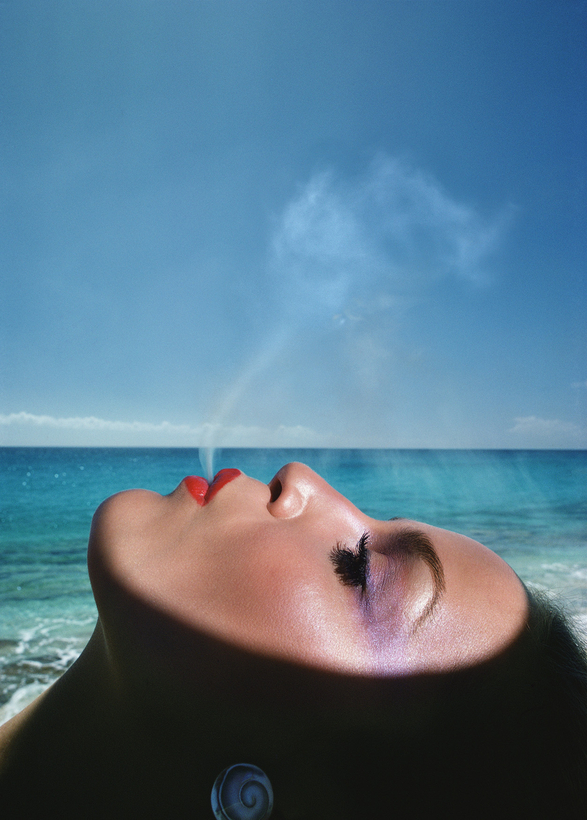When Yasuhiro Wakabayashi began taking photographs for Harper’s Bazaar, the magazine’s art director Alexey Brodovitch gave him some sage advice. “If you look in your camera and see something you’ve seen before, don’t click the shutter,” he told him.
It was a dictum that Hiro, as he was known professionally, stuck to over a long career as a fashion photographer, although such a trite job description hardly does justice to the singularity of his oeuvre. His work included fashion spreads, up-market advertisements for jewelers such as Tiffany, still life and portraiture, but he frequently gave his compositions — for that is no less than what they were — a surreal sensibility that had as much in common with the paintings of Magritte as it did with conventional magazine photography.
Making elegant use of bold colors, unorthodox lighting, surprising perspectives and startling juxtapositions, the precisely realized intensity of his pictures made the mundane seem exotic and revealed extraordinary beauty in the ordinary.

His images seemed to “burn their way into your eyeball”, one critic suggested. There was a gold bracelet on a piece of white bone with a pair of red ladybirds crawling over it, and a diamond-and-ruby necklace adorning the hoof of a black Angus bullock.
There was a Van Cleef & Arpels choker draped around a fish in such a way that it took several seconds to realize the jewelry was not part of the marine creature’s skin. Perhaps most striking of all as a summation of his unique aesthetic was the image of a black ant atop a manicured toenail, painted fire-engine red.
When the magazine American Photographer devoted an entire issue to his work in 1982, his pictures were presented under the headline, “Is this man America’s greatest photographer?”. The clear inference was that the answer was yes. “With the pragmatic brilliance of a Renaissance master, Hiro has changed the way photographs look, and with an endlessly inventive technique has changed the way photographers work,” the magazine wrote.
His images seemed to “burn their way into your eyeball”, one critic suggested.
Richard Avedon, who was his hero and his mentor, called him “one of the few artists in the history of photography” and edited a lavish book of his photographs. Hiro, however, maintained a low personal profile and was a reticent champion of his own work.

Despite his reluctance, his images are in the permanent collections of galleries and museums around the world, including London’s V&A and the J Paul Getty Museum in Los Angeles.
His process almost bordered on the obsessive. His assistants were instructed always to pass the camera to his left hand because he believed that such a ritualistic way of working helped him to focus and “intensify the gaze”.
The remarkable nature of many of his images bore the imprint of an equally unusual backstory. A celebrated 1974 image of smoke coming out of the mouth of a model in sensual plume, for example, was inspired by childhood memories of the prewar opium dens in Shanghai, where he was born. In characteristically exacting fashion, rather than manipulate the image in the studio, he spent long hours teaching Maria Beadeux, his model, how to blow languorous fumaroles of smoke in a way that made them linger in the air.

One of five children, Yasuhiro Wakabayashi was born in 1930 to Japanese parents living in China, ostensibly because his father was employed on compiling a Japanese-Chinese dictionary, although a procession of late-night clandestine visitors led his son to believe that he may also have been an agent for the imperial regime in Tokyo.
When Hiro was six, Japanese troops invaded China and the Sino-Japanese War began. Within hours of the outbreak of hostilities, the Wakabayashis were on a flight back to Japan, although they returned a few months later after the Battle of Nanking and spent the rest of the war in occupied Peking, where Hiro attended a Japanese school. After the atomic bombs had been dropped on Hiroshima and Nagasaki and the Japanese had surrendered, the 14-year-old Hiro and his family were interned for five months before being repatriated in 1946 to a Japan in ruins and under Allied military occupation.

Working as a tutor in Japanese to US officers in Tokyo, he became fascinated by American popular culture and discovered the work of Avedon in the American magazines that he read.
He bought himself a camera and began photographing Japan’s postwar devastation. In 1954 he emigrated to the US and after two years as an assistant to commercial photographers, Avedon offered him an apprenticeship at his studio in New York.
His boss was so struck by his ability that within months Avedon had recommended him to Brodovitch, who in 1957 offered Hiro a job as a staff photographer at Harper’s Bazaar. His work for the magazine won him the photographer of the year award from the American Society of Magazine Photographers in 1969, when he shot the launch of Apollo 11. He photographed the take-off with infrared film, producing vivid green and yellow tones with spectators silhouetted in the glow.

He went freelance in 1975 and opened his own studio, branching out into portrait photography, but with the same distinctive approach. The ever-image-conscious Rolling Stones were among his first clients.
He is survived by his wife Elizabeth Clark, a set designer whom he married in 1959, and by their two sons, Gregory Wakabayashi, a New York-based art director and designer, and Hiro Clark.
“He appears to reduce fashion, like everything he photographs, to a simple but surprising arrangement,” the critic Mark Holborn wrote in an anthology of Hiro’s work. “The boundaries between portrait, still life and fashion seem to vanish.”
Hiro, photographer, was born on November 3, 1930. He died of undisclosed causes on August 15, 2021, aged 90

